
The GE-200 series was a family of small mainframe computers of the 1960s, built by General Electric (GE). GE marketing called the line Compatibles/200 (GE-205/215/225/235). The GE-210 of 1960 was not compatible with the rest of the 200 series.
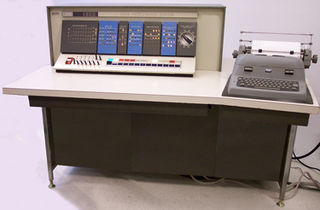
The IBM 1620 was announced by IBM on October 21, 1959, and marketed as an inexpensive scientific computer. After a total production of about two thousand machines, it was withdrawn on November 19, 1970. Modified versions of the 1620 were used as the CPU of the IBM 1710 and IBM 1720 Industrial Process Control Systems.
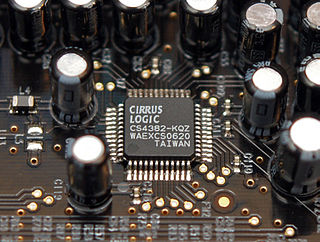
In electronics, a digital-to-analog converter is a system that converts a digital signal into an analog signal. An analog-to-digital converter (ADC) performs the reverse function.
A music sequencer is a device or application software that can record, edit, or play back music, by handling note and performance information in several forms, typically CV/Gate, MIDI, or Open Sound Control, and possibly audio and automation data for digital audio workstations (DAWs) and plug-ins.

A digital audio workstation is an electronic device or application software used for recording, editing and producing audio files. DAWs come in a wide variety of configurations from a single software program on a laptop, to an integrated stand-alone unit, all the way to a highly complex configuration of numerous components controlled by a central computer. Regardless of configuration, modern DAWs have a central interface that allows the user to alter and mix multiple recordings and tracks into a final produced piece.
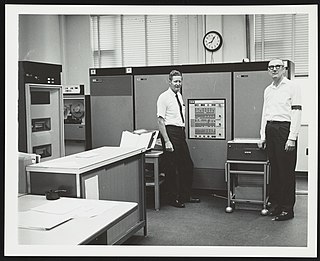
The IBM 1800 Data Acquisition and Control System (DACS) was a process control variant of the IBM 1130 with two extra instructions, extra I/O capabilities, 'selector channel like' cycle-stealing capability and three hardware index registers.
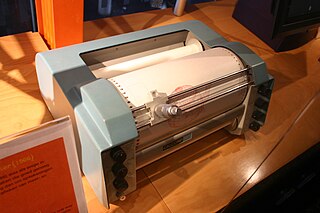
Calcomp plotters were the best known products of the California Computer Products company.

The IBM 1712 Multiplexer and Terminal Unit is part of the IBM 1710 process control computer. The Terminal Unit provides the physical connections between factory wiring and the computer. The 1712 can support up to 300 separate wire pairs. Signal types supported include analog input, analog output, contact sense, contact operate, process branch indicators and process interrupts. Special terminal blocks support thermocouple inputs. The Multiplexer selects which signal is connected to the IBM 1711 Data Converter.
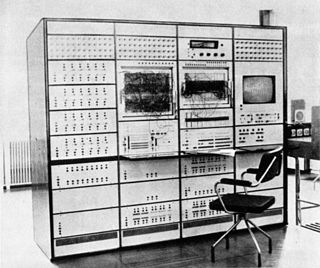
Hybrid computers are computers that exhibit features of analog computers and digital computers. The digital component normally serves as the controller and provides logical and numerical operations, while the analog component often serves as a solver of differential equations and other mathematically complex problems.

Elliott Brothers (London) Ltd was an early computer company of the 1950s and 1960s in the United Kingdom. It traced its descent from a firm of instrument makers founded by William Elliott in London around 1804. The research laboratories were originally set up in 1946 at Borehamwood and the first Elliott 152 computer appeared in 1950.

Librascope was a Glendale, California, division of General Precision, Inc. (GPI). It was founded in 1937 by Lewis W. Imm to build and operate theater equipment, and acquired by General Precision in 1941. During World War II it worked on improving aircraft load balancing.

The CDC 160 series was a series of minicomputers built by Control Data Corporation. The CDC 160 and CDC 160-A were 12-bit minicomputers built from 1960 to 1965; the CDC 160G was a 13-bit minicomputer, with an extended version of the CDC 160-A instruction set, and a compatibility mode in which it did not use the 13th bit. The 160 was designed by Seymour Cray - reportedly over a long three-day weekend. It fit into the desk where its operator sat.
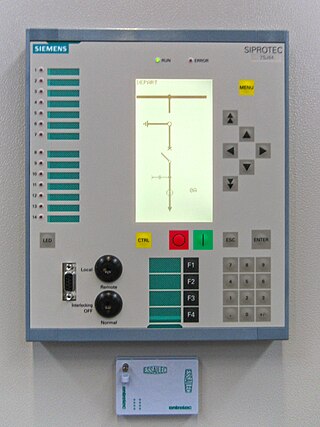
In utility and industrial electric power transmission and distribution systems, a numerical relay is a computer-based system with software-based protection algorithms for the detection of electrical faults. Such relays are also termed as microprocessor type protective relays. They are functional replacements for electro-mechanical protective relays and may include many protection functions in one unit, as well as providing metering, communication, and self-test functions.

The Monroe Calculating Machine Mark XI was a general-purpose stored-program electronic digital computer introduced in 1960 by the Monroe Calculating Machine Division of Litton Industries. The system was marketed for "primarily for billing, and invoice writing", but could also be used for low-end scientific computing.

The IBM 1443 Printer is an obsolete computer line printer used in the punched card era. It was offered in three models: Models 1, 2 and N1; the last two could print up to 240 lines per minute (LPM) with a full character set.
The PB 250 was a general-purpose computer introduced in 1960 by the Packard Bell Corporation.














